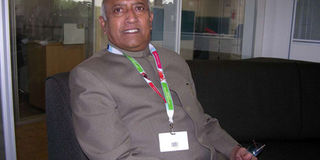Astronaut’s call to save Earth

Rakesh Sharma speaks during the interview. PHOTO | LEOPOLD OBI | NMG
What you need to know:
- Space technology is a tool for development.
- They also provide information on where fish are concentrated and where to find minerals.
- Being in space is such an experience.
- There were other experiments such as testing how the cardiac system weighs up in zero gravity.
Rakesh Sharma was the first Indian in space. He went with Russians Yuri Malyshev and Gennadi Strekalov in 1984. Sharma, 68, talked to Leopold Obi during the UN environment conference in Nairobi
How does space exploration relate to pollution?
When you go into space, you realise the fragility of our planet. It is protected by a very thin layer of the atmosphere.
If an object falls towards the earth, because of the presence of the atmosphere, the friction is too high that the object burns up so that very little is left by the time it comes through the atmosphere. So the atmosphere is very life giving. While on one hand it protects us from radiation, on the other hand it is what we breath to live.
During my flight, there was a forest fire in Myanmar and the smoke was rising. It was blown as far as Indonesia. You could see it from Space. It brought home the reality that pollution is not confined to one area.
How has space technology helped India in monitoring environmental resources and disasters?
Space technology is a tool for development. The Indian space programme is the only one that has never entered the space race.
We concentrate on satellites to improve lives. Because of the satellites, there are phone and TV networks in every corner of India.
They also provide data for agriculture and available water bodies. The satellites tell us how much snow there is in the Himalayas and how much water will be available for irrigation.
They also provide information on where fish are concentrated and where to find minerals.
Can developing countries like Kenya access such information?
All this information is available except countries that have these technologies sell their services. However, data alone is not enough. You will need infrastructure to interpret the data and a team to oversee the connection.
Can one get out of a space shuttle and take a stroll?
Space is a vacuum. If you leave the craft without protective clothing, your body fluids will boil. Death is instant.
Everything floats. If your drinking water spills, it becomes a ball and floats around. The floating water may damage computers.
Being in space is such an experience. It took us 90 minutes to go round the earth. We remained in space for eight days.
So where did your journey to space did begin?
I was a fighter pilot in the Indian air force, then became a test pilot. While there, I was called up for selection for the space flight in the Soviet Union. I went to Star city near Moscow in 1982 for training.
It was 18 months of tough training but the most difficult part was learning Russian. The training culminated in the space flight in April 1984. We photographed India using remote sensing cameras.
There were other experiments such as testing how the cardiac system weighs up in zero gravity.
After my return, India did not have a manned space plan so I went back to my old job. I left the military at 53 and joined the IT industry where I remained for eight years before retiring.
Was it something you ever dreamt of doing?
No, I didn’t. There was nothing happening during our time. I was in high school when Yuri Gagarin became the first man in space.
That is when I understood that it was possible to travel to space. I dreamt of being a pilot and focused on that.
I just got lucky to be selected for the space programme.





